-

人教版新目标初中英语七年级上册What time do you go to school教案
知识与能力复习词汇time,morning,breakfast,get up,g0 t0 bed,homework,clock,afternoon,lunch,run,watch TV,evening,dinner,eat,usually,o’clock,thirty,fifteen,take a shower,go t0 school等;引导学生复习、巩固“询问和谈论时间”的目标语言并运用所学知识安排自己的学习和课外活动。过程与方法运用Summarizing,Classifying和Comparing的学习策略。在复习教学中,运用听写、提问、对话演练与调查活动,促使学生不断地使用所学内容,从而提高他们灵活运用知识的能力。情感态度价值观本部分的主要内容是复习“日常作息时间”的询问和表达。通过互相询问或谈论自己或对方的作息时间安排和活动计划,培养学生良好的作息习惯和守时习惯。教学重、难点及教学突破重点复习词汇time,morning,breakfast,get up,g0 to bed,homework,clock,afternoon,lunch,run,watch TV,evening,dinner,eat,usually,o’clock,thirty,fifteen,take a shower,go to school等;引导学生复习、巩固“询问和谈论时间”的目标语言。

人教版新目标初中英语八年级上册Can you come to my party教案3篇
Step 3 (3b)First, tell the students when we talk about our future plans, we often use: I’m+verb+ing When we talk about what we must do, we use have to. Ask the students to fill in the blanks in 3b. The answers are: shopping, go to see, a test, I’m going, my family. Step 4 (3c)Let the students write an e-mail message to a friend. Say why you can’t visit next. Before the exercise, ask the students to give some possible answers and write them on the blackboard. So the students will feel easy to finish the writing exercise. After they finish it, Let them to correct it in groups first. Each group chooses theirs best one to read in front of the whole class. Step 5 ( planning a party )First read the conversation in the box together. Then ask the students to turn to page 88.Write down everything you have to do next week. Write in all the things you have to do . Ask the students to look at the list. Ask them “What day are you free?” This is when you can have your party. Step 6 (Self check 1 )Let the students to fill in the blanks with the words given. Change the forms of the words if possible. Then make their own sentences. The answers are: visit, playing, have to, study, comeStep 7 (Self check 2)Imagine you are Marie. Read the information and look at your schedule. Write replies to the invitation.

人教版新目标初中英语八年级上册How do you make a banana milk shake教案2篇
1. First, ... then, ... next, ... finally, ...首先,……然后,……接着,……最后,……这是英语中表达做某事的步骤的一种说法。如果步骤较多,还可以说:first-next-after that-later on-finally/at last通常你会听到说英语国家的人在说 first, next, then, finally 和后面的内容时,他们会做一些停顿。这样就能提前告诉听者接下来讲的是一系列的步骤。这一点在朗读和听力中应特别注意。2. how many, how much均为疑问词,同是“多少”,但用法不同。请看:how many修饰可数名词复数,how much修饰不可数名词。但在用法上,同学们常犯如下错误:1) [误] How many are there bananas on the table?[正] How many bananas are there on the table?[析] how many, how much 中的many,much是形容词,常修饰名词作定语,故后面跟名词。2) [误]How much tea are there on the table?[正]How much tea is there on the table?[析] how much修饰不可数名词时,谓语动词用单数。how many与how much的区别可简记为:前how many:问“多少”,复数名词后面跑;how much问“多少”,不可数名词单数好。前者答语用基数词,后者答语用数量关系。

人教版新目标初中英语八年级上册How was your school trip教案2篇
“Go for it!” is based on “Task-Based Language Teaching”. It adheres to “The authenticity principle”, “The form-function principle”, “The task dependency principle” and “The principle of learning by doing”. These principles all accord with the demands of curriculum focus.In and of Grade Seven (II), “Go for it!”, students have learned “The Simple Past Tense”. And it appears again in of Grade Eight (I). teaches students more about how to talk about events in the past. In addition, it gives affirmative and negative statements in the past tense, such as the sentence patterns “Did you see …?” “Were there …?” “Did you go …?” As the first part of Unit 8, Section A opens with a picture presenting the last school trip in the aquarium and continues with several step-by-step practice activities, which are all good for students to master “The Simple Past Tense”. Doing well in Section A will help students integrate the new target language with that in Section B. Thus, they can describe the events in the past freely and foster their own ability of reflecting and practicing. II. Teaching ObjectivesTeaching objective is the beginning and aim of teaching activities. According to the overall goal of the English elementary course--- improve students' synthetic ability of language application, which should be based on the development of students’ “Language knowledge”, “Language skills”, “Character building”, “Learning strategies” and “Cross-cultural awareness”. The teaching objectives are described as follows(I). Knowledge objectivesi. Master the simple past tense of regular and irregular verbsii. Recite the new words and expressions about the last school trip in the aquarium, including their pronunciation and intonation

人教版新目标初中英语八年级上册Could you please clean your room教案3篇
一、 教学内容Section A 1a----1c二、 教学目标1.学习词汇do the dishes, make the bed, take out the trash, fold the clothes, do the laundry, sweep the floor, clean the living room.2.句型 Could you please clean your room? Yes, sure.三、 教学准备 学生预习本单元所有的词汇多媒体课件 活动表 奖品四、 教学过程Pre-task1. Warming upEnjoy ourselves. Watch cartoon Cinderella. 看动画片段《灰姑娘》导如入本课话题和新词汇“chores”美丽善良的鬼姑娘因继母的嫉妒,每天得做所有的家务。片段的主题使学生联想到本课的话题。2. learn new words and phrasesLook! What is she / he dong? 看图学习动词词组do chores, do the dishes, make the bed, take out the trash, fold the clothes, do the laundry, clean the living room.3. Guessing game.What is she doing ? 4. Pair work. 1a, Do you do these things at home? Write “Y” for “yes” and “N” for “no”.5. Listening . 1b , Peter’s chores or Mom’s chores?理解目标语Could you please clean your room? Yes, sure.Write “M” for Mom’s chores, “P” for Peter’s chores in the chart.6. PairworkLook at the picture,Ask your partner to do the chores that you see. 7. Interview Who is the most able at home? 1) What chores do you do at home? How often do you do the chores? Work in four, interview each of the students in the group, fill in the chart.

人教版新目标初中英语八年级上册How do you get to school教案2篇
Step Ⅶ Role play ( Work on 1b)1. First ask two students to read the dialogue to the class.Sa: How do you get to school?Sb: Well, I ride my bike to the subway station. Then I take the subway.2. Now work with a partner.Suppose you use two kinds of transportation to get to school \Hangzhou\Beijing... (bus, train, subway, walking, bike, etc.) Tell how you get there. You may use the phrases in 1a.3. Then ask different pairs of students to present their conversations to the class.Step ⅧListening1. Work on 2a(1) First ask students to read the list of information that Thomas wants to know.…where Nina lives.…how far from school she lives.…how long it takes to get to school.…how she gets to school.…what she thinks of the transportation.(2) Tell students what transportation and bus stop mean.bus stop 汽车站 transportation n. 运送;运输Then tell students we'll hear a recording. Please put a checkmark in front of each thing that Thomas wants to know.(3) Now play the recording for students.( Have students pay attention to the sample answer.) (4) Then correct the answers.

人教版新目标初中英语八年级上册I’m going to be a basketball player教案3篇
教学目标1.知识目标:(1)学习What are you going to be when you grow up?/How are you going to do that?句式。(2)学会用英语描述有关职业的表达法。2.能力目标:(1)能够谈论为实现理想所做出的打算和安排。(2)能够谈论未来自己与他人理想的职业及原因。(3)能用英语描述课余时间的活动安排,最终具备表达综合信息的能力。3.情感目标:新学期到来之际,让他们在学习、体育、饮食、特长、读书等方面制定计划,教育学生合理安排自己的课外生活,思考自己的理想职业及适合自己的职业。教学重点、难点本单元的重点为“be going to”表将来,want to be, what,where, when,how引导的特殊疑问句。难点是语言目标的实现。教材分析本单元以I am going to be a basketball player为话题,共设计了三部分的内容:一、Section A该部分有4个模块。第一模块围绕Do you think these jobs are interesting?这一话题展开思维(1a)、听力(1b)、口语(1c)训练;

人教版新目标初中英语八年级上册I’m more outgoing than my sister教案2篇
1 交通工具的比较此活动为小组活动。学生通过讨论找出到达某一城市可乘坐的各种交通工具,并选择最佳出行方式。Teacher:We’re going to Shanghai. How many ways can we use to get there? Yes, there are four ways: by bus, by plane, by train, by ship. Please discuss how you are going to get there.操作建议:(1)学生以小组为单位展开活动,谈论本组所选择的交通工具。(2)各组选代表向全班汇报,阐述本组所选择的交通工具的利和弊。完成任务所需要的语言结构:We can go there by ship. It’s more comfortable and cheaper than any other transportation.We can go there by bus. It’s cheaper but it takes longer time.2 哪个城市更合适?此活动具有挑战性。假设中国要举行2014年世界杯足球赛,分别从历史,人文,天气等方面对各城市(北京,大连,上海,昆明)进行比较,选择最佳举办城市。T: Imagine China is holding the 2014 FIFA World Cup. Which city do you think is the best for the World Cup, Beijing, Dalian, Shanghai or Kunming? Let’s work in groups. If you choose Beijing, please join the Team Red. If you chose Dalian, please join the Team White. If you choose Shanghai, please join the Team Blue. If you choose Kunming, please join the Team Green. Please show us its advantages. Then let’s see which team will win.
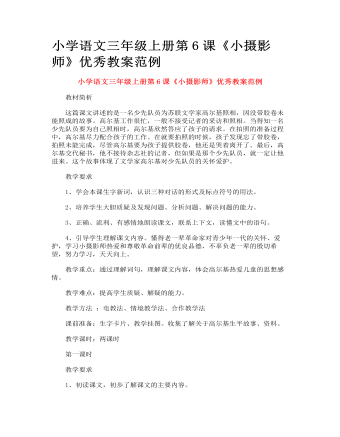
小学语文三年级上册第6课《小摄影师》优秀教案范例
介绍人物,导入新课 1、启发谈话。课前同学们自己已经读过了课文,查阅了有关资料,谁能向大家介绍一下高尔基? 2、学生之间交流收集的有关高尔基的资料。 3、师出示高尔基的画像,并归纳:高尔基(1886年~1936年),是苏联伟大的无产阶级文学家,世界著名的文学家。他写了很多书,发表了《童年》、《在人间》、《我的大学》、《母亲》等多部小说以及著名的散文诗《海燕》和一系列剧本。“书籍是人类进步的阶梯”这句脍炙人口的名言,就出自高尔基的笔下,全世界人民都很敬爱他。他的作品在我国广为流传,得到人们的喜爱。今天,我们来学习高尔基与一位小学生之间的故事:小摄影师。(板书,提示“摄”的读音。) 高尔基与小摄影师之间到底发生了什么事呢?我们下面来看课文
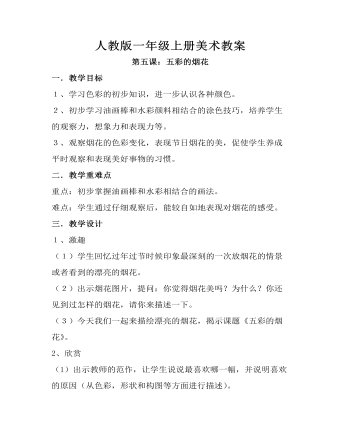
小学美术人教版一年级上册《第5课五彩的烟花》教案
二.教学重难点重点:初步掌握油画棒和水彩相结合的画法。难点:学生通过仔细观察后,能较自如地表现对烟花的感受。三.教学设计1、激趣(1)学生回忆过年过节时候印象最深刻的一次放烟花的情景或者看到的漂亮的烟花。(2)出示烟花图片,提问:你觉得烟花美吗?为什么?你还见到过怎样的烟花,请你来描述一下。(3)今天我们一起来描绘漂亮的烟花,揭示课题《五彩的烟花》。
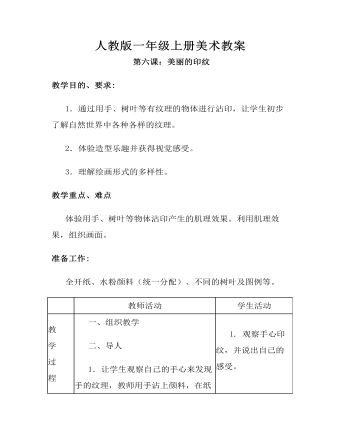
小学美术人教版一年级上册《第6课美丽的印纹》教案
3.让学生讨论并说说除了手之外,还可以用什么东西来印。三、布置作业1.团结协作;2.注意卫生;3.比一比,哪一组印得最美丽。
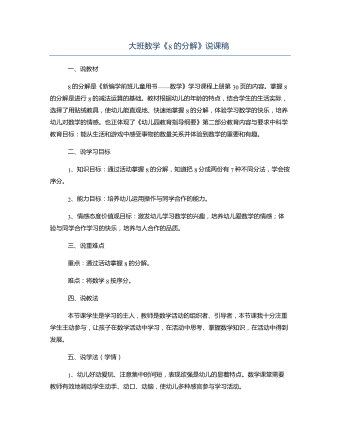
大班数学《8的分解》说课稿
8的分解是《新编学前班儿童用书——数学》学习课程上册第30页的内容。掌握8的分解是进行8的减法运算的基础。教材根据幼儿的年龄的特点,结合学生的生活实际,选择了用贴绒教具,使幼儿能直观地、快速地掌握8的分解,体验学习数学的快乐,培养幼儿对数学的情感。也正体现了《幼儿园教育指导纲要》第二部分教育内容与要求中科学教育目标:能从生活和游戏中感受事物的数量关系并体验到数学的重要和有趣。1、知识目标:通过活动掌握8的分解,知道把8分成两份有7种不同分法,学会按序分。2、能力目标:培养幼儿运用操作与同学合作的能力。3、情感态度价值观目标:激发幼儿学习数学的兴趣,培养幼儿爱数学的情感;体验与同学合作学习的快乐,培养与人合作的品质。
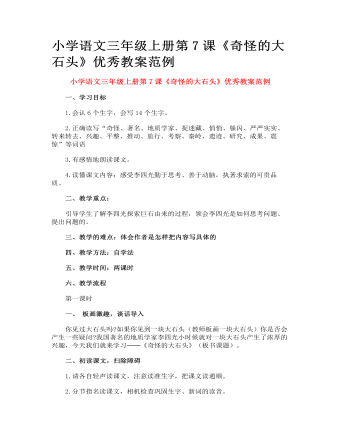
小学语文三年级上册第7课《奇怪的大石头》优秀教案范例
质疑解难 1.结合资料袋中的内容介绍本文主人公一李四光。 2.学生针对课文内容质疑,师生共同解疑。 (1)对预习认真,能主动、正确解疑的同学给予表扬。 (2)主要解决以下疑难: 陨石:大的流星在经过地球大气层时,没有完全烧毁坠落到地球上的含石质较多或全部为石质的陨星。 地质学家:从事地球物质形成和地壳构造研究,以探讨地球的形成和发展的科学家。 突兀:高耸。 第四纪:地质历史的最后一个纪。约250万年前至今。此时高纬度地区广泛地发生了多次冰川作用。 冰川:在高山或两极地区,积雪由于自身的压力变成冰块(或积雪融化、下渗冻结成冰块儿又因重力作用而沿着地面倾斜方面移动,这种移动的大冰块叫做冰川。在地质上的新生代第四纪,气候非常寒冷,世界上的许多地方被冰川覆盖,称第四纪冰川。 秦岭:横贯我国中部,东西走向的古老语皱断层山脉。我国地理上的南北分界线。分布有冰川槽谷、角峰等。
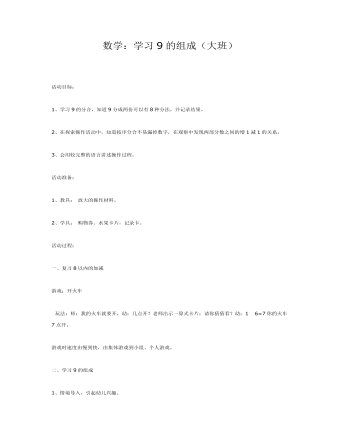
大班数学:学习9的组成课件教案
2、在探索操作活动中,知道按序分合不易漏掉数字,在观察中发现两部分数之间的增1减1的关系。3、会用较完整的语言讲述操作过程。活动准备:1、教具: 放大的操作材料。2、学具: 购物券、水果卡片,记录卡。活动过程:一、复习8以内的加减
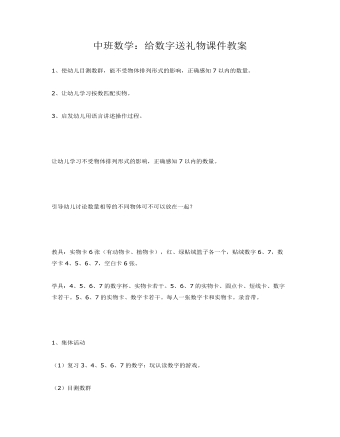
中班数学:给数字送礼物课件教案
2、让幼儿学习按数匹配实物。3、启发幼儿用语言讲述操作过程。让幼儿学习不受物体排列形式的影响,正确感知7以内的数量。引导幼儿讨论数量相等的不同物体可不可以放在一起?
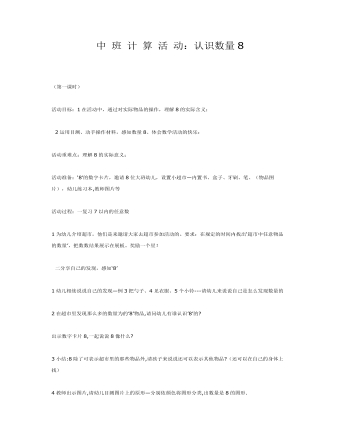
中班数学:认识数字8课件教案
2运用目测、动手操作材料,感知数量8、体会数学活动的快乐:活动重难点:理解8的实际意义;活动准备:‘8’的数字卡片,邀请8位大班幼儿,设置小超市—内置书、盒子、牙刷、笔、(物品图片),幼儿练习本,教师图片等活动过程:一复习7以内的任意数1为幼儿介绍超市,他们是来邀请大家去超市参加活动的。要求:在规定的时间内找出‘超市中任意物品的数量’,把数数结果展示在展板。奖励一个星! 二分享自己的发现,感知‘8’1幼儿相续说说自己的发现—例3把勺子、4见衣服、5个小铃---请幼儿来说说自己是怎么发现数量的
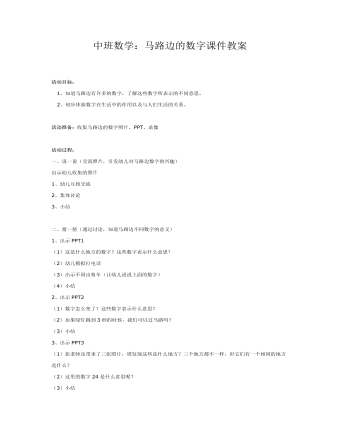
中班数学:马路边的数字课件教案
2、初步体验数字在生活中的作用以及与人们生活的关系。 活动准备:收集马路边的数字照片、PPT、录像 活动过程:一、说一说(交流照片,引发幼儿对马路边数字的兴趣)出示幼儿收集的照片1、幼儿互相交流2、集体讨论3、小结

中班数学:家里的数字课件教案
三、准备: 1、幼儿人手一张记录卡; 家里的数字: 2、课件制作:我的家 课件一:家里的各种物品(鞋、桌子、椅子、茶杯、玩具、电视机等物品)。 4 6 5 3 2 1 课件二:厨房、客厅、卧室。 三、过程: 观看录像一)、认识数字,理解6以内各数字的实际意义: 1、幼儿交流记录卡,说说在家中发现了哪些数字? A、直观的数字(数序):如、电话上的数字、钟上的数字、电器上的数字;
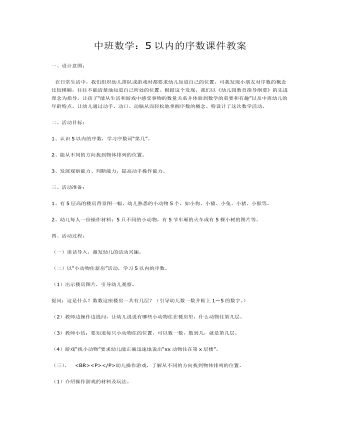
中班数学:5以内的序数课件教案
二、活动目标:1、认识5以内的序数,学习序数词“第几”。2、能从不同的方向找到物体排列的位置。3、发展观察能力、判断能力,提高动手操作能力。三、活动准备:1、有5层高的楼房背景图一幅,幼儿熟悉的小动物5个,如小狗、小猫、小兔、小猪、小猴等。2、幼儿每人一份操作材料:5只不同的小动物,有5节车厢的火车或有5棵小树的图片等。
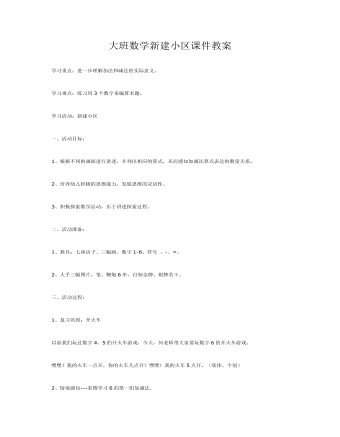
大班数学新建小区课件教案
学习活动:新建小区一、活动目标: 1、根据不同的画面进行讲述,并列出相应的算式,从而感知加减法算式表达的数量关系。 2、培养幼儿积极的思维能力,发展思维的灵活性。3、积极探索数学活动,乐于讲述探索过程。二、活动准备:1、教具:七座房子、三幅画、数字1-6、符号 、-、=。2、人手三幅图片,笔、鞭炮6串、自制金牌、银牌若干。

